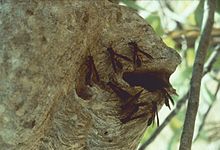Polybia sericea
| Polybia sericea | |
|---|---|
 |
|
| Scientific classification | |
| Kingdom: | Animalia |
| Phylum: | Arthropoda |
| Class: | Insecta |
| Order: | Hymenoptera |
| Family: | Vespidae |
| Genus: | Polybia |
| Species: | P. sericea |
| Binomial name | |
|
Polybia sericea (Olivier, 1792) |
|
Polybia sericea is a social, tropical wasp of the family Vespidae that can be found in South America. It founds its colonies by swarming migrations, and feeds on nectar as well as other arthropods.
P. sericea is medium in size, and has a dark-colored body. The wasps build multi-tiered nests, and colony size can vary greatly between a few workers to a few thousand. Queens can be distinguished from workers by their greater body size and smaller head size. They tend to be polygynous, meaning that there are several egg-laying queens within a nest, with the result that workers are generally less related to each other than in other eusocial species. Workers are responsible for hunting and foraging, while queens are responsible for laying eggs, and have the most developed ovaries. When hunting for prey, workers rely heavily on visual and olfactory cues. Prey include arthropods such as green and brown caterpillars.
Polybia sericea is a species within the genus Polybia of subfamily Polistinae.Polybia is the most diversified genus within tribe Epiponini, which is characterized by colony founding via swarming. Placement of Polybia among related genera has fluctuated, and the genus may be paraphyletic.
P. sericea individuals are medium sized wasps, about 17 mm long. They are dark in color, and tend to be slow-flying and docile, unless they are disturbed. Queens typically have larger abdomens, and smaller heads and wings than workers.
Workers build enclosed, multi-tiered roughly spherical nests of carton paper maché-like pulp of plant fibres chewed with saliva. Nests are reddish-brown in color, and are not very large. They are typically built between two and five meters off the ground, in the branches of trees or shrubs.
...
Wikipedia
